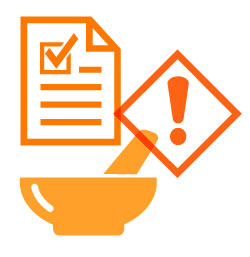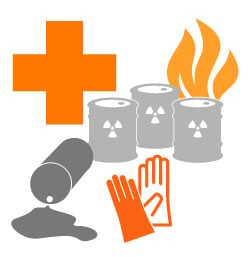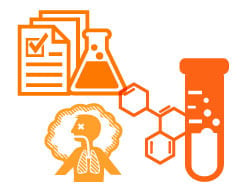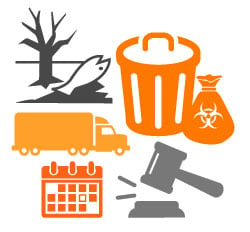Parts of a Safety Data Sheet (SDS)

Under the international standard called the Globally Harmonized System, or GHS, details about a chemical or mixture are provided in a standardized reference document called a Safety Data Sheet, or SDS. National laws based on GHS, such as OSHA's Hazard Communication System (HazCom 2012) in the United States, also use the same format.
The SDS format includes sixteen sections. These parts must appear in their given order, and each part must contain specific kinds of information for the material that the SDS describes. As a result, while one SDS may look different from another, they will always have the same fundamental structure. This makes it much easier to find a given detail, no matter who created the SDS.
SDS Parts 1-3: Basic Chemical Details

The first few sections of an SDS will include the most important and most basic information. In fact, most readers won't need to go further than section 2 to find the data they need.
Section 1: Identification includes the basic information about the chemical itself. This includes the Product Identifier, or the name of the material as it appears on a container label, as well as any other ways to identify the material, such as its typical uses. The name, address, and phone number of the product's supplier will also be here in the first section.
Section 2: Hazard Identification describes the product's chemical hazards. This will include the classification of the chemical in the international GHS system, or in a national implementation of GHS, like HazCom 2012.
In addition to specifying the types of hazards that the material presents, the Hazard Identification section will include the signal word, hazard statements, symbols, and precautionary statements that should appear on the material's container labels. If the material also poses a hazard that is not covered in the GHS classification, like radioactivity, that should be described in this section.
Section 3: Composition/Information on Ingredients identifies what the product is made of, in chemical terms. To protect trade secrets, the composition section may give limited information, such as concentration ranges (like "15-35%") instead of exact proportions. This section may even state that the actual composition of the product is withheld as a trade secret, and not disclose any further information about the ingredients.
If a supplier chooses not to disclose the details here, the information must still be available in the event of a legitimate need; specific rules for this disclosure process are up to the national implementation of the rules. OSHA's rules for this process are in paragraph (i) of the HazCom regulations.
SDS Parts 4-8: Recommended Actions

The next several sections of the SDS focus on recommended actions, providing the steps that workers and incident responders should follow to keep safe. These are presented with the most urgent information first.
Section 4: First-Aid Measures gives the appropriate steps for immediate response to a personal exposure to the material. These steps could be followed by someone without any special medical training. If more advanced medical attention would be called for, this section will identify the type of attention needed.
Section 5: Fire-Fighting Measures provides any important precautions or special instructions for fighting a fire where the material is present. Some chemicals become much more dangerous in these circumstances, and some react dangerously to common fire-fighting methods (such as exposure to water).
Section 6: Accidental Release Measures provides the appropriate instructions and warnings for responding to a spill of the material. Typically, this section will include whatever steps are needed for clean-up.
Section 7: Handling and Storage describes any special notes or warnings about keeping or moving the material safely, including any notes about the container for the material or safe storage temperatures.
Section 8: Exposure Controls and Personal Protection covers elements like Personal Protective Equipment (PPE) needed for typical day-to-day safety when the material is used in a workplace. Having these recommendations available will help facilities create safe work procedures.
SDS Parts 9-11: Technical Details

At this point, the information that a typical worker may need has already been provided. Now, the SDS gets into the technical details of the material, describing the nature of the material and where its hazards come from, in chemical terms.
Section 9: Physical and Chemical Properties lists laboratory-testable identifying details about the material, such as its pH, flash point, and solubility.
Section 10: Stability and Reactivity provides chemical details about the reactions that the material may undergo. If any particular situations, such as vibration or static discharge, could cause a dangerous reaction, that will be specified here.
Section 11: Toxicological Information gives medically-oriented details about the material's health effects, ranging from routes of exposure to toxic symptoms, and including any known information on long-term effects such as carcinogenicity.
SDS Parts 12-16: Information for Specific Needs

The last several sections of the SDS are for the information that's only needed for specific concerns or at specific times. Because these sections cover a variety of situations, their contents may not be important for all applications. In order to meet the GHS standard format, however, every SDS still needs to include each of these sections.
Section 12: Ecological Information is for environmental concerns that may be posed by a material. For example, mercury is toxic to humans, but will also build up in aquatic ecosystems, posing a serious hazard for fish and other aquatic wildlife. In the United States, these concerns fall under the jurisdiction of the Environmental Protection Agency (EPA), and not OSHA.
Section 13: Disposal Considerations covers issues of wastes and waste residues, as well as any important rules for proper disposal of contaminated packaging. Depending on the nature of the material, this may also be important for the EPA.
Section 14: Transport Information describes any special rules or considerations for transporting the material safely, including international identification systems such as a designated U.N. Number and U.N. Shipping Name, if applicable. If there are any special precautions for shipping the material, they are listed here. In the United States, this section is particularly relevant for the Department of Transportation (DOT).
Section 15: Regulatory Information is the catch-all section for any other regulatory details that apply to the material. For example, many states have their own specific rules that apply to individual chemicals or combinations of materials; where those rules apply, the SDS should mention them in this section.
Section 16: Other Information is useful for a variety of other, non-regulatory details. Often, this will include information about the SDS itself, rather than about the material. Items like the date when the SDS was prepared, and an explanation of any abbreviations used in the document, should appear here.
Referring to an SDS
Once you know where information will be located, you are much closer to understanding the SDS. If your real problem is managing a stack of Safety Data Sheets, finding the SDS for an obscure material, or handling the other complexities of chemical management, look into the powerful Chemwatch Chemical Management service.
Related Resources

Understanding the SDS (Safety Data Sheet)
Chemical safety can be a massive puzzle, with a variety of interconnected elements: inventory lists, storage ...
Read
From MSDS to SDS
OSHA's HazCom 2012 rules require companies to have a Safety Data Sheet (SDS) for every hazardous chemical in ...
Read
Avert Chemical Safety Program Failures
Facilities that handle chemicals need to be aware of the potential hazards of each chemical. Part of ...
Read.png)





